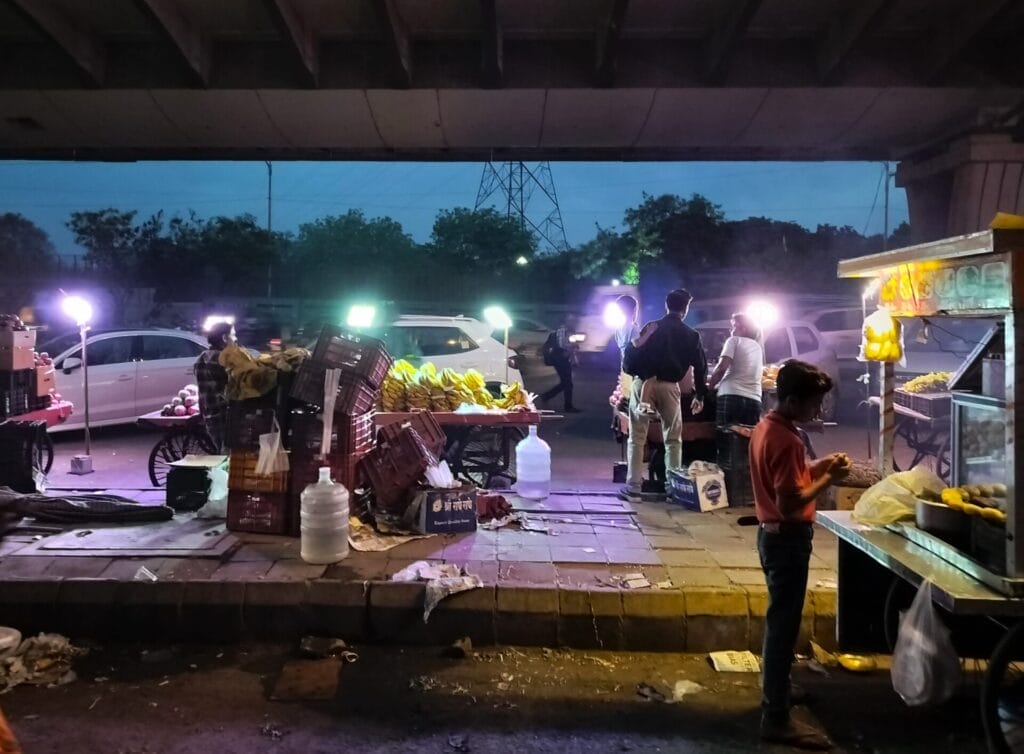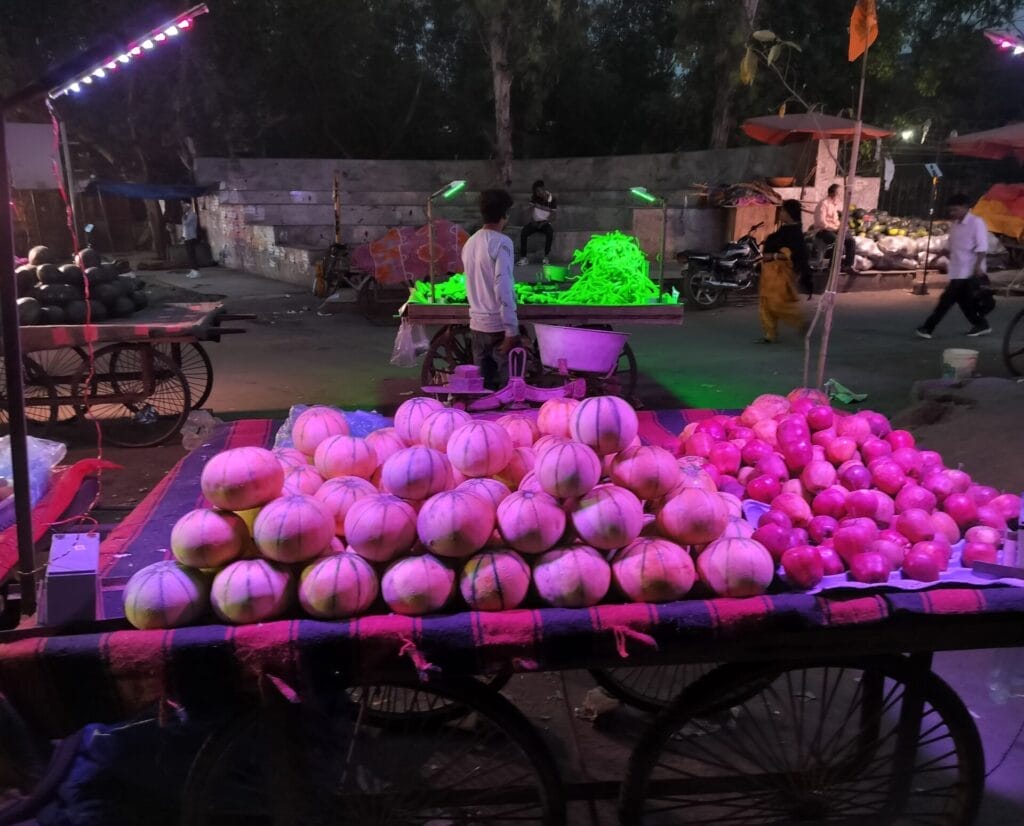Halfway through our interview, vegetable vendor Rekha asked me point blank, “Isse kya hoga,” and at that moment, I could not think of an answer. She was right and had every reason to be hopeless. Much has been written about air pollution and much energy has been spent on expert committees and political debates and yet nothing has changed.
“Hum toh garib log hai, hum kisko jakar bole, hamari sunvai nahin hoti” (We are poor people, to whom do we go, nobody listens to us),” says Rekha Devi, who sells vegetables in the Keshopur Mandi. Keshopur is a large retail and wholesale vegetable and fruit market located in West Delhi.
It is close to the Keshopur Industrial Area, Outer Ring Road and the Najafgarh Drain, where garbage is often burnt. All these factors combined with other local pollutants, add to the extremely poor air quality of this area.
Pollution in Keshopur cannot be measured, as the area does not have an AQI monitoring station. However, nearby pollution recorded by the nearby AQI stations are indicative of the situation here. Mundka and Punjabi Bagh record pollution in the “severe” category. The average PM 2.5 is 431, and PM 10 is 372. PM 2.5 and PM 10 measure the amount of particulate matter in air of the size of 2.5 and 10 micrometres respectively.
Such dangerous levels of fine particles cause irreversible damage to lungs, irritation in eyes and increase chances of asthma.
Livelihood or health: Vegetable vendors’ dillema
“Hamare paas koi chara nahin hai’,’ (We have no other option) says Rekha when asked if she has ever skipped coming to the Mandi on days of extremely poor smog. Rekha, like many other fruit and vegetable sellers in the area, has no choice but to come here to sell every day, even in these hazardous conditions. Daily wagers do not have the luxury of working from their homes, like more fortunate ones who stay indoors when the pollution levels are alarming.
The vendors do not use protective masks either. Rekha said she almost never wears a mask. Most of the vegetable sellers in the Mandi were also without a mask, because of the inability to buy masks every week and the lack of awareness.

Rekha pitches her stall at around 2:00 pm in the afternoon and stays there till 1:00 am in the morning. These long hours in the open have led to irritation in her eyes and persistent coughing. Late nights in the winter also require people to burn wood to keep themselves warm, producing a lot of smoke. The vendors stand for hours in the unbreathable air.
The Energy Policy Institute concluded that the people of Delhi are likely to lose 11.9 years of their lives, if the current levels of pollution continue.
Unaffordable health care and vegetable vendors
Kishan Lal, who sells grapes in the Mandi, said he has had chronic coughing for the past year. The doctor at the dispensary says that it is due to pollution. He took medicines for a few months but then stopped because he didn’t have any insurance. He cannot afford to take bed rest on days his cough gets uncontrollable. He says, “Garib aadmi ka to kya hai, roz kamana, roz khana.”
Rekha says, “Hamein bachhon ka bhi dekhna hai, rent pe rehti hu, vo bhi har mahine bharna hota hai. (We have to look after our kids’ education. I live in a rented house. I have to pay the rent each month).
People, who were interviewed, did not have any serious medical problems due to prolonged exposure to air pollution. However, they worried about how their lives would be, if they were diagnosed with such a disease. They do not have any savings and are completely dependent on government-funded dispensaries for their healthcare.
Read more: Why the national programme for clean air failed a gasping Mumbai
Shrinking livelihoods, worsening pollution
The irony is that while the sellers continue to stay put on days of bad smog, the buyers do not come. Moreover, business has also dwindled after the pandemic, as people have switched to e-commerce services for grocery and vegetable shopping.
Another trend, which the vegetable sellers speak about, is people not going inside the main market area. They prefer to buy things from the nearby hawkers without stepping out of their cars.
This shows how socio-economic status of people determines their response to pollution. Although everyone is affected by air pollution and has the right to clean air, the ability to cope and stand up against the system varies from person to person.
Increasingly, Rekha and many others in the community feel helpless.

The right to have clean air is an ideal that every citizen of Delhi wants, but when it comes to air pollution, it often does not garner the same attention as other hot-button political issues.
And when measures are put in place, they have had only short-term impact. For example, the Winter Action Plan of the Delhi Government aimed to deploy hundreds of dust-collecting and spraying machines to control particulate matter.
However, as Rekha rightly points out, these dust machines have often caused pollution in the area by impeding traffic flow.
Read more: Air Pollution: More blue days than blue skies in India’s cities
Government response to pollution
Parvesh Verma, MP for West Delhi, has repeatedly attacked the AAP government in Punjab and Delhi for not doing enough to control pollution. He also has questioned the central government on under-staffing in state pollution control boards. Delhi’s pollution has figured in the promises of political leaders in the upcoming elections too.
Health emergency such as this requires urgent policy redressal from the government. It begins with understanding that different areas in Delhi have different sources and causes of pollution and require different strategies.
The Principal Secretary (Environment and Forest), Department of Environment, Government of Delhi has been reached out for a comment on this story but we did not receive a reply.
Recommended measures to control pollution
A 2021 analysis by the Centre for Science and Environment showed that vehicles are the biggest contributor to particulate pollution among the local sources in Delhi. Congestion pricing on the Outer Ring Road at peak hours in the morning and evening would discourage people from using personal cars.
The Delhi government should regulate unauthorised industries, install smoke filters and accelerate the transition from traditional to clean energy in all approved industrial areas of Delhi.
Pollution in a mixed land use suburb like Keshopur comes largely from factors outside of the area. The government needs to ban outside burning and provide N-95 masks to the vegetable sellers. But it also needs to address the problem of dust and PM2.5 pollutants within the area.
Lastly, the Keshopur Sabzi Mandi Committee should serve as the platform for the demands of these vegetable sellers to have a better working environment. It should adopt dust mitigation practices for the large Sabzi Mandi built on unpaved ground.
It can become an example of civic-led action to secure progress for an entire community.
The author is a member of the cohort of the Civic Journalism Training Programme, jointly hosted by Oorvani Foundation and Youth ki Awaaz. This article was produced under the programme.